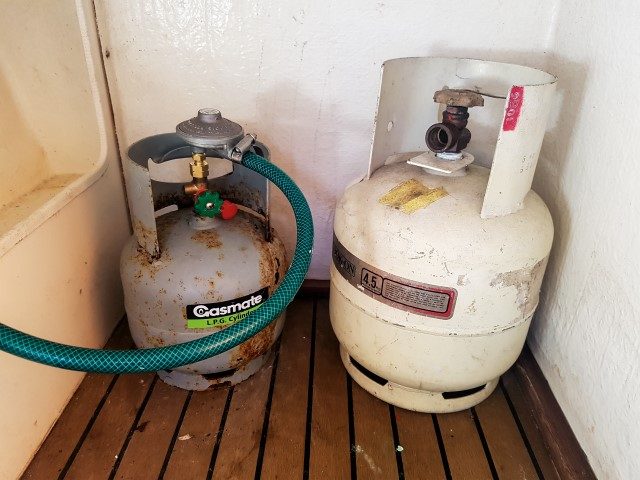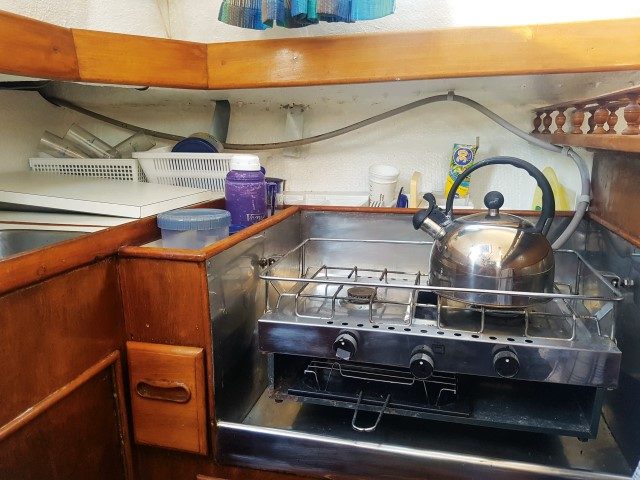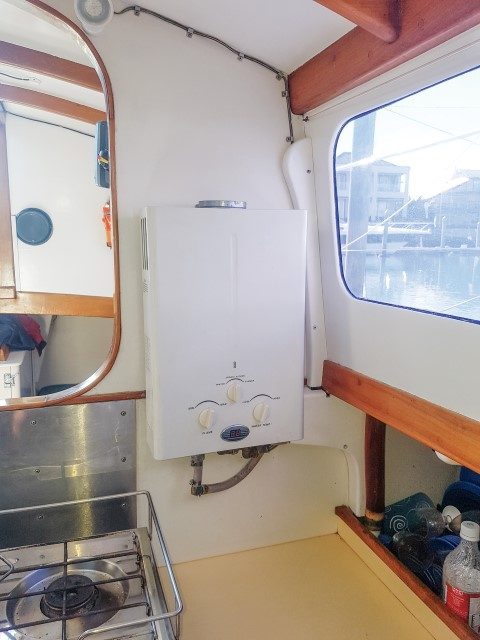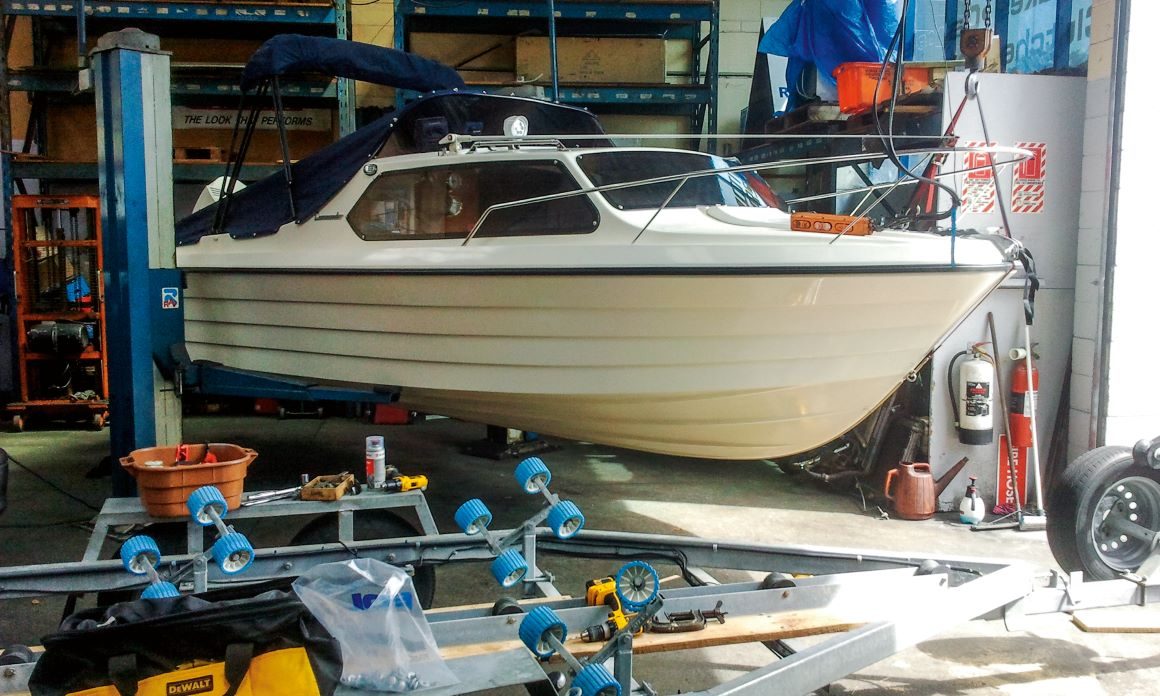

Gas installations on New Zealand boats often lag far behind existing gas regulations. Certified fitter Robb Baird says not a week goes by where he doesn’t see something life-threatening on a vessel. Looking for a Plumber or Gas fitter? Robb can be contacted on: 0508 OPTIMUM (6784686) MOBILE: 021 168 4913 info@optimumplumbing.co.nz
There are endless examples of how not to do it – califonts installed directly above a gas cook top in the galley, garden-hose used as a gas line, gas bottles stored against an exhaust manifold in the engine room – and on it goes.
They all underscore the importance of the Marine Gas Regulations introduced in 2013. Gas fitting is about installing gas pipes, appliances and flues. The legal definition and scope of this work is found in the Plumbers, Gas fitters and Drainlayers Act of 2006.

The definition is comprehensive and makes it illegal for any person to undertake this work unless properly qualified. The rationale may seem obvious – fire and/or explosions. But these are not, in fact, the main danger. The vast majority of deaths and injuries result from carbon monoxide poisoning – because of incomplete combustion and improper flues for gas appliances.
Common installation errors on boats vary tremendously. They include types of gas appliances, incorrect gas pressure, bad gas locker storage locations and poor venting choices. But one that pops up over and over again is the pipework and fittings used for gas.
PIPEWORK
I’ve seen installations using clear plastic pipe, garden hose, irrigation pipe, plumbing pipe and other tubing material that doesn’t meet industry standards – and they’re all downright dangerous.
Furthermore, the pipework connection to fittings and regulators usually uses a jubilee clip. Over time
plastic pipes become brittle – to a point where they can crumple under the force of a jubilee clip. Plastic pipes are also run through bulkheads with no protection around sharp edges. Boat movement chafes and wears the pipes, causing a gas leak.
There are two main types of pipe material that comply with the current regulations for connecting a regulator to appliances: 316 stainless steel pipe and, more commonly, a plastic-coated annealed copper tube (see NZS 3501). This coating protects the copper from corrosion and chafing, so it’s ideal for a marine environment.

A certified hose assembly must be used for the final connection to your gas appliance if needed as this allows for movement of the gas appliance – for example a stove/ oven on a gimbal. For boats with only one gas appliance on board the use of a hose assembly to AS/NZS 1869 is permitted as long as it is one continuous length (no joiners or tee pieces) and as short as practicable to prevent kinking and damage to the hose. This pipework must be accessible for regular inspection.
All pipework should then be clipped, secured, protected from vibration and at least 25mm from any electrical service and 100mm from exposed live fittings, and sealed when passing through partitions. When pipework is installed in an engine room or sleeping accommodation area, the pipework must be
one continuous length with no joins or branch tees.
TWO LIFE-SAVING DEVICES EVERY BOAT SHOULD HAVE
The first is a BEP marine gas detection system. In most instances gas appliances on boats are situated below the upper deck, with no low-level ventilation. They therefore require a system as described above to comply with regulations.
Not only does this system allow you to isolate your gas supply by means of a solenoid at the bottle by a push of a button on the control panel, it also allows for two sensors, one mounted in the vicinity of the gas appliances and one at the lowest point where gas would likely to accumulate in the event of a leak.
When these sensors detect gas the supply of gas is automatically isolated and an audible and visual alarm is activated. A detector is the greatest investment for any boat’s gas system.
The other is a carbon monoxide detector capable of detecting low concentrations of carbon monoxide (CO). It should also have an audible alarm. When gas doesn’t burn properly, excess CO is produced. CO is an odourless, colourless, tasteless gas, but it’s poisonous and it can kill in a
matter of hours.
You’re particularly at risk when asleep because you won’t recognise the early symptoms of CO poisoning – tiredness, drowsiness, headache, nausea, pains in the chest and stomach pains.
CYLINDER COMPARTMENTS AND LPG GAS LOCKERS
Common mistakes include gas bottles stored in the galley cupboard right next to the cooker, gas bottles rolling around freely in the engine room, gas bottles stored right next to a petrol container, spare batteries placed in the locker next to the gas bottle, and califonts screwed to the side of a gas locker.
Most boats have a gas locker outside in the aft cockpit area – generally the safest and most compliant place. I would never accept any gas bottle being installed or stored inside a boat.
There are eight key components all gas lockers should have: a drain, means of restraint, correct identification labels, sealed access door, a suitable high-pressure connection to the gas bottle
followed by an adjustable regulator set to 3kPa, a shut-off valve followed by a test point.
This test point allows the gas fitter to test the system for leaks as well as make sure your system is operating and maintaining the correct gas pressure during peak demand.
Your cylinder compartment locker should be fully-sealed to prevent any gas vapour from entering any enclosed section of the boat. It should also have a drain at the base not less that 19mm in diameter, which is lead outboard to a point lower than the bottom of the locker.

There should be no ignition sources within 1.5m of the locker and all cylinders should be restrained at all times. A clearly marked LPG sticker on the outside of the locker is needed as well as a sticker on the inside of the cylinder compartment stating: only cylinders and their associated equipment are permitted in the cylinder compartment.
Electrical equipment, batteries, or ignition sources must not be installed in the cylinder compartment and your gas bottles should always be secured upright and never be stored on their sides: if the safety relief valve opens for any reason, liquid rather than vapour will be escaping, posing a much greater
danger. Remember the same rules apply to spare/stored LPG cylinders on boats.
GAS APPLIANCES
Specific rules also apply to gas appliances on boats. Every appliance should have a sticker or data plate. It contains important information for the gas fitter when it comes to completing a gas certificate, and helps with the rating and correct setting up of the appliance.
A common fault with gas appliances involves DIYers buying freestanding cookers and hob tops designed for natural gas, not LPG. These are usually installed without being converted by a licensed gas fitter.
When connected to LPG these pose an instant risk due to the different pressures involved. Natural gas and LPG appliances operate at different pressures – 1.1 kPa and 2.75 kPa respectively. The incorrect installation can lead to fire because of a much larger flame and appliance malfunction.
Every gas appliance on a boat must have a flame-failure device fitted to every burner. This prevents the uncontrolled release of gas. These devices close down the gas supply in the event of ignition- or flame-failure. Such failures are typically caused by wind or appliance malfunction.
Note that clearances around a gas cooking appliance should also be in accordance with the manufacturer’s specifications – and it varies from appliance to appliance.
CALIFONTS
A major mistake I see over and over again is a water heater/califont installed inside a boat. Most people think califonts simply need a flue to the outside. This is wrong.
When an instantaneous water heater lights up it needs fresh air for combustion. This air is drawn from the area in the vessel where the unit’s situated. The Code states “there shall be no ventilation openings to a sleeping or living area.” So unless the califont is completely room-sealed or draws air directly from the outside and is vented to the outside – and has the proper clearances – it is not to be installed inside a boat.
Any boat owned in New Zealand with gas appliances/bottles on board should hold a Gas Fitting Certificate Code of Compliance. The certifying gas fitter should lodge details of the work on the high-risk
database managed by Energy Safety within 20 working days of issue of the Certificate of Compliance.

Imagine this: your family is asleep and you have a sudden water leak or burst pipe in the hot water line. Your gas califont starts up and runs all night until: A. you run out of fresh water or B. you run out of gas.
If your gas califont has been installed incorrectly or illegally (as 99 percent of califonts installed inside of boats are), there is a very good chance no one will waking up in the morning due to CO poisoning.
Always remember when a gas fitter steps on board ask to check his license to ensure you are dealing with someone that knows what he is doing. Gas is not something that you can play around with and if regulations aren’t followed things can go horribly wrong. When purchasing a gas appliance always look for the gas safety compliance label.
IS YOUR BOAT LPG-COMPLIANT?
If you use LPG gas on your vessel be aware that many insurers are now requiring that the gas installation is certified. To meet the requirements, Auckland’s Westhaven Marina recommends that you:
• Fit gas detectors into your bilge area with two sensors, one in the vicinity of your gas appliances and one at the lowest point where gas is likely to accumulate (usually in the bilge)
• Insist that any gas work is done by a qualified installer
• Get the work certified and provide your insurance company with the details. Boats not only require a gas certificate but also require the work to be lodged on the Energy Safety website’s high-risk database, which a qualified gas fitter will take care of for you.
Aaron Mortimer of Mariner Marine Insurance says that with the regulations being modified in 2010 and 2013, it’s possible that some boaties are buying boats that previously were compliant but now are not.
If the survey indicates any concerns about the gas system, cover will be made dependent on certification from a gas fitter, or Mariner will ask for the gas bottle to be removed until the system is certified.
The Plumbers, Gas Fitters and Drainlayers Board says that a certificate is the gasfitter’s verification that the work is lawful and compliant. The Board provides guidelines for selecting a tradesperson to help you and for verifying the tradesperson is properly qualified.
“One of our customers had a scary near-miss recently when his cabin and bilge was filled with gas,” says Westhaven Manager Kevin Lidgard. “Fortunately, this was noticed by our dock-master in the nick of
time, but the end result could easily have been very different – in the worst-case injury or death, with significant damage to the vessel and neighbouring boats.”
If in any doubt, have your gas installations checked and discuss it with your insurance company.
For more detailed information, explore the NZS 5428:2006 standard – LPG installations for non-propulsive purposes in caravans and boats – or ask a qualified gas installer for details.




